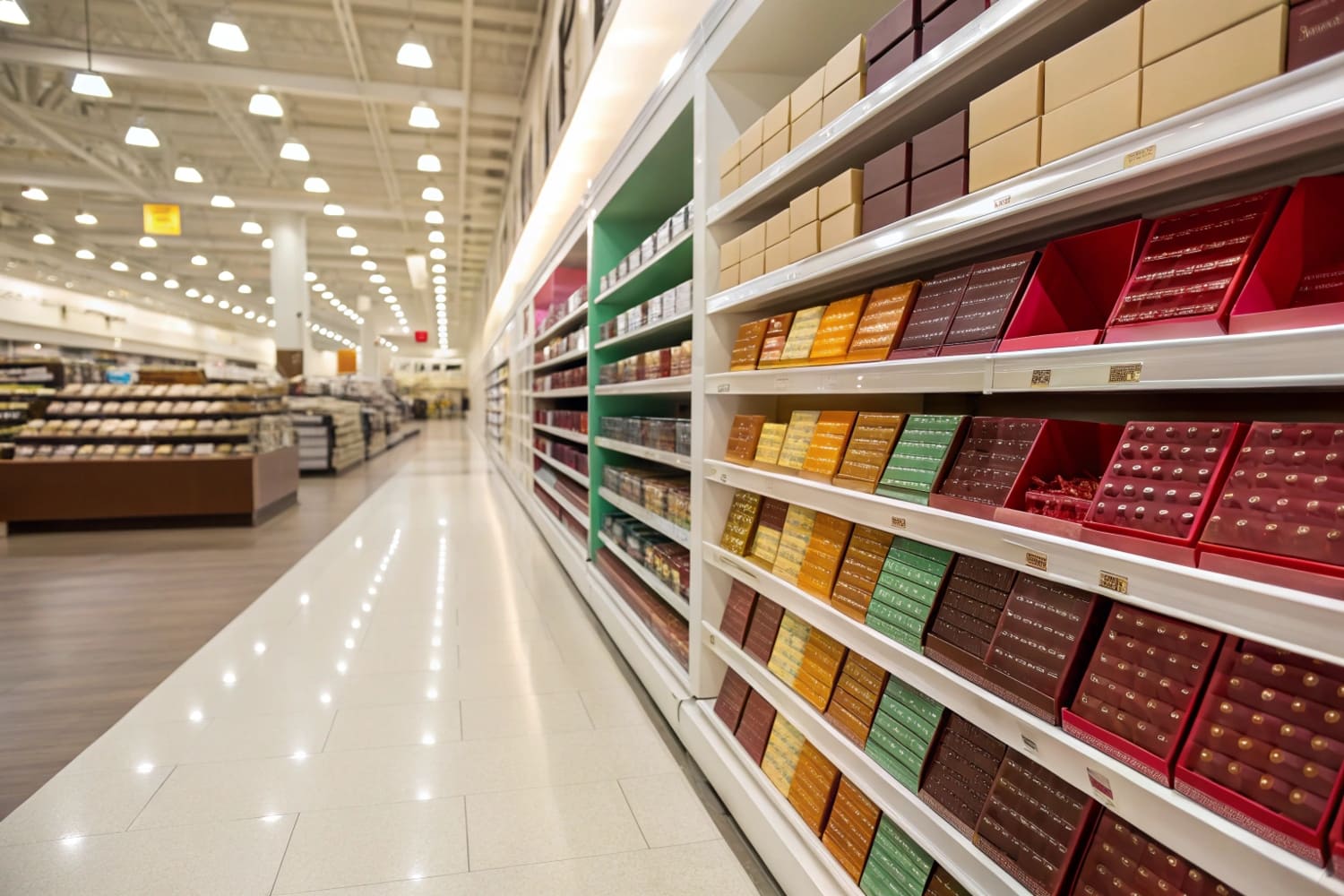Messy shelves lose sales. Shoppers ignore products they cannot find. I have seen this when my cardboard displays arrive without thought for the store crew. Retail-ready packaging ends the chaos and keeps items visible.
Retail-ready packaging is a shipping box that turns into a shelf-display in seconds, lowering store labor, protecting goods, and driving quicker sales from neat, eye-level presentation.
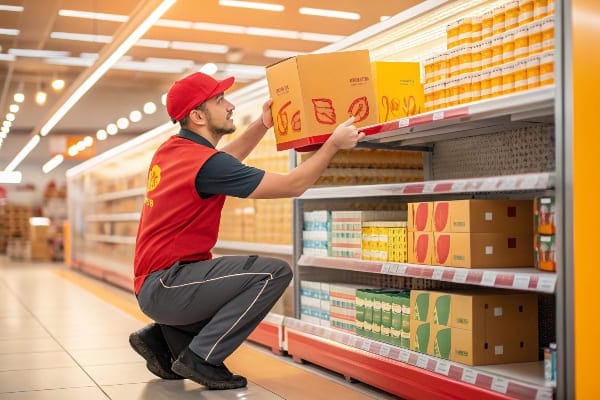
Retail buyers decide in split seconds. If a product shows up shelf-ready, staff place it faster, managers trust the brand, and my repeat orders rise. The sections below unpack every piece of the idea.
Why is packaging important in retail?
Crowded aisles confuse shoppers. Poor packs hide brand value. I once watched a big chain reject a whole pallet because the boxes looked weak. The store lost patience and I lost shelf space.
In retail, packaging protects the product, draws attention, tells the story, and speeds stocking; without it, loss, damage, and missed sales rise fast.
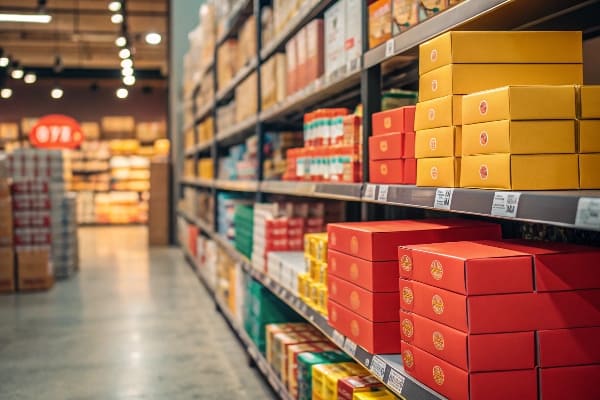
How Packaging Drives Every Stage
Retail hinges on speed and trust. Good packs tackle both. They guard items during the brutal ride from my factory in Guangzhou to a Michigan warehouse and then to the sales floor. Graphics speak for me when I am not there. Clear tear-strips cut setup time by minutes per SKU. Those minutes multiply across stores.
Functions and Failures
| Function | Outcome if Done Right | Pain if Done Wrong |
|---|---|---|
| Protection | Fewer returns, steady margins | Broken goods, lost credibility |
| Branding | Instant recognition, impulse buys | Bland look, lost identity |
| Efficiency | Faster replenishment, lower labor cost | Stockroom backlog, empty pegs |
| Compliance | Pass audits, smoother rollouts | Penalties, delisting risks |
I learned the hard way. Early runs skimped on board strength. Displays sagged, colors shifted, and buyers emailed photos of crushed corners. I now spec double-wall flute, test every lot, and include clear handling icons. These changes lifted my on-time acceptance rate above ninety-eight percent. Retailers notice and reorder because I removed headaches they once blamed on me.
What does "retail ready" mean?
Store teams race clocks. They need packs that pop straight onto shelves without knives or repacking. My clients call me only when every second counts.
“Retail ready” means the carton arrives shelf-presentable, opens without tools, shows clear graphics, and meets store guidelines for barcodes, count, and facing height.

The Five R Standards I Follow
| R Standard | What I Do in the Factory | Benefit to the Store |
|---|---|---|
| Readable1 | Print bold UPC on three sides | Quick scanning |
| Recognizable | Match brand colors with Pantone checks | Instant shopper trust |
| Replenishable2 | Add tear-away front | Zero tool shelf fill |
| Robust3 | Use E-flute + B-flute hybrid | Minimal damage |
| Recyclable | Source FSC kraft liners | Easy disposal |
I walk buyers through these points on video calls. We open a prototype together, time the action, and tweak the die-lines. For Barnett Outdoors, we cut setup to under ten seconds per bow accessory. Their engineer David saw the saving and signed a year contract with three reorder slots. The design won because it hit the five R’s without fancy extras.
What are the benefits of shelf ready packaging?
Retail wages climb. Chains slash staffing. A pack that needs scissors costs money. While visiting a Midwest store, I watched two clerks wrestle open taped OEM cartons. Meanwhile my shelf-ready crossbow hooks rolled straight out.
Shelf-ready packaging cuts labor, reduces waste, keeps planograms tidy, boosts impulse sales, and lowers damage, raising net profit for both supplier and retailer.

Numbers That Convince Buyers
I gather data from pilots. A 500-store rollout with a sports chain showed the following results versus traditional cartons:
| Metric | Old Carton | Shelf Ready4 | Improvement |
|---|---|---|---|
| Stocking Time per Unit | 45 s | 12 s | −73 % |
| Floor Damage Rate | 4 % | 0.6 % | −85 % |
| Sales Lift Week 1 | — | +9 % | — |
| Cardboard Waste | 0.18 kg | 0.05 kg | −72 % |
Labor saved paid for the die-cut cost in three weeks. Waste drop pleased sustainability teams5. Most vital, the nine-percent sales pop became evidence I use in every pitch deck. Retailers like proof. My simple table turns a talk into a deal.
Hidden Gains
Shelf-ready units also act as silent sales reps. Consistent facing keeps color lines straight, signaling quality. Faster replenishment means fewer gaps, so shoppers never stare at empty racks and drift to rivals. I include QR codes on inner flaps, leading to videos that show the product in use. When a hunter scans while idle in the aisle, they watch a crossbow shoot and feel the thrill. The code sits hidden until the pack opens, staying clean on the journey.
What is retail packaging?
Customers judge first, buy later. Retail packaging is more than a box; it is the handshake. I learned this when a gift show attendee told me, “I trust what looks professional.”
Retail packaging is the consumer-facing container that protects, informs, and persuades, shaping the first impression at the point of sale.
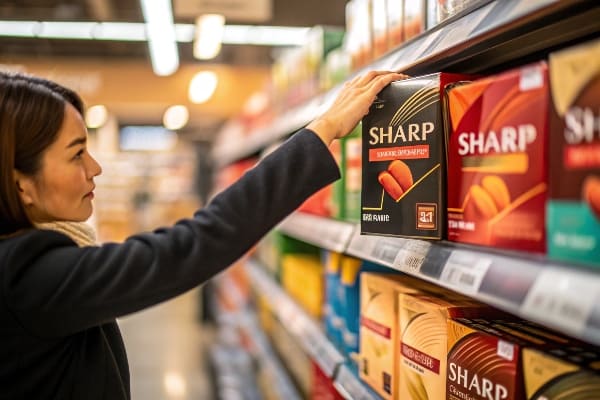
Elements I Build Into Every Pack
| Element | Purpose | Simple Check |
|---|---|---|
| Structural Design6 | Fit product snug, prevent rattle | Shake test: no noise |
| Visual Story7 | Show use case, brand vibe | Three-meter rule: message clear from aisle |
| Legal Info | Safety icons, origin, disposal symbols | Compliance sheet ticked |
| Shelf Footprint | Match planogram slot | Width tolerance ±2 mm |
| Unboxing Flow8 | Delight user, reduce returns | Open with two moves max |
Retail packaging differs from transport cartons because it must romance the buyer. I pick matte lamination over gloss for rugged hunting gear. A soft-touch finish pairs with bold orange brand marks, mirroring Barnett’s ethos. Inside, a fold-back lid invites quick inspection while locking tabs reset for resale returns. Such small touches cut return rates and build goodwill without big cost.
What is the difference between OEM packaging and retail packaging?
Factories love bulk. OEM packs aim for cheap, dense shipping. Retail packs aim for charm. Mixing the two invites trouble, as I found when an overseas forwarder loaded OEM white boxes straight onto a display—sales stalled.
OEM packaging focuses on safe bulk transport between businesses, while retail packaging focuses on attracting and informing shoppers at the shelf.
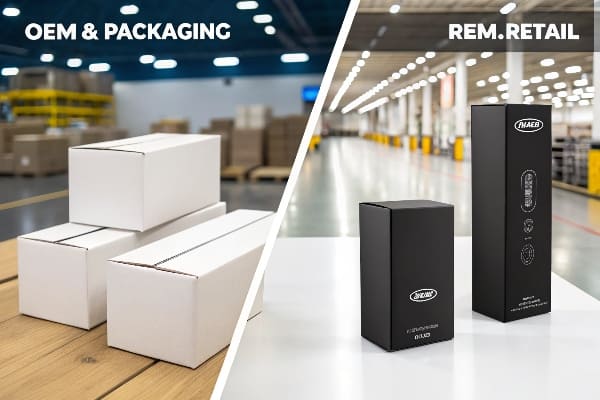
Head-to-Head Comparison
| Feature | OEM Packaging9 | Retail Packaging10 |
|---|---|---|
| Primary Goal | Protect during freight | Persuade and protect on shelf |
| Branding Level | Minimal or none | Full graphics and copy |
| Unit Orientation | Pallet bulk | Individual facing |
| Opening Method | Box cutter | Perforation or tab |
| Cost Focus | Lowest material cost | Balanced cost and appearance |
| End User | Distributor/Assembler | Shopper |
Why Mixing Fails
An OEM carton uses plain corrugate and heavy tape. A store clerk must cut it open, pull out plain inner items, and then hand-stack them. Time drags. Shoppers see brown boxes or bare products and doubt quality.
Retail packs, in contrast, often double as a mini shelf. They need stronger inks, die-cut windows, and sometimes PET windows. The cost per unit runs higher, yet the turnover outpaces the added cents. When David first tested my switch from OEM to retail packs, his accessories moved thirty percent faster in outdoor shops. He recovered the pack premium within two weeks.
For smooth supply, I now split production lines: bulk OEM for warehouse kits and retail-ready for planogram launches. My ERP tags them clearly so the wrong box never ships.
Conclusion
Retail-ready packaging saves time, protects goods, and drives sales. Invest in it once, and every reorder rewards you and your buyers.
Explore how readable packaging enhances customer experience and boosts sales in retail environments. ↩
Learn how replenishable packaging can streamline operations and reduce costs in your supply chain. ↩
Discover the best materials for creating robust packaging that minimizes damage during transport and storage. ↩
Explore how shelf ready packaging can enhance product visibility and sales, making it a game-changer for retailers. ↩
Discover how sustainability teams influence packaging choices and drive eco-friendly practices in retail. ↩
Understanding Structural Design can enhance your packaging strategy, ensuring products fit snugly and attractively, reducing returns. ↩
Exploring Visual Story can help you create packaging that resonates with consumers, enhancing brand perception and sales. ↩
Learning about Unboxing Flow can improve customer experience, leading to higher satisfaction and lower return rates. ↩
Understanding OEM packaging will help you grasp its role in logistics and cost efficiency, crucial for supply chain management. ↩
Exploring this resource will provide insights into how retail packaging enhances product appeal and drives sales. ↩

